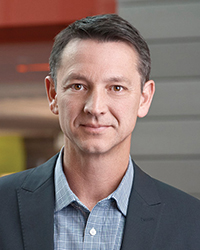


Editor’s note: This post is part of our ongoing exploration of how design is responding to the COVID-19 pandemic. https://www.gensler.com/design-responds-to-a-changing-world
Over the past seven weeks, North America has come to a screeching halt. The voluntary and mandatory stay-at-home orders in response to the COVID-19 pandemic have emptied our freeways, airports, and once-congested roadways. The data coming through is staggering. By the third week of March, when U.S. responses to the virus picked up momentum, New York City saw a 90% reduction in mobility, according to Citymapper.com. Cities everywhere have been witness to similar slowdowns.
We all look forward to recovering safely from this pandemic and reopening our schools and businesses, but along the way the crisis is shedding light on some old and new concerns about mobility, our streets, and the future of cities. Our wholesale shift in live-work-play behaviors as a result of COVID-19 have provided us an opportunity to rebalance public rights-of-way.
Taking back streets for people
With the dramatic fall in traffic we’ve seen in major cities, busy streets have transitioned into much-needed release valves for pedestrians and cyclists seeking a break from quarantined isolation. To maintain safe social distancing, cities have extended sidewalks into the roadway by temporarily blocking off travel lanes and curbside parking.
The city of Oakland, for example, announced plans to open up 74 miles of streets for pedestrians and cyclists to get outdoors and exercise safely. Implemented in phases, the city’s plan is to use temporary obstacles and vehicular obstructions to create a full network of “slow streets” where vehicles, pedestrians, and cars can safely commingle.
Many other U.S. cities, from Boston to Minneapolis, are initiating similar measures. And in Italy, the city of Milan has announced it will rapidly transform 22 miles of streets in an experimental expansion of cycling and walking space to protect residents as COVID-19 restrictions are lifted.
Without the threat of infectious disease, it has proven all but impossible to create protected rolling lanes and/or widen sidewalks when faced with opposition from motorists, who are already frustrated by congested streets. Sidewalks, in fact, have been losing ground. Just stroll along any sidewalk in any American city and take note of all the real estate lost to traffic lights, electrical equipment, outdated telephone booths, bus stops, newspaper boxes, and roadway signs. Providing a place to walk seems almost an afterthought.
But now that we’ve parked our cars, we have seen and experienced what we always knew to be true: gas-powered cars pollute. Communities around the world are experiencing clean air for the first time in living memory. Los Angeles, the poster child for air pollution, has been logging some of the cleanest air of any city in the world.
We suddenly have living proof that any move away from fossil fuel-burning vehicles, whether by shifting modes (to public transportation, walking, biking, or micro-mobility) or by widespread adoption of electric vehicles and green-charging infrastructure, will have a measurable positive impact on human health and the environment.
Our collective over-dependence on fossil fuels has been the major roadblock to carving out more public space for safe pedestrian and active transportation options — and to cleaning up our urban air. But now, when we’ve all been forced to change our behaviors so radically, we have a unique opportunity to adopt new behaviors and expectations as we slowly get back to normal.
Here are some strategies and tactical moves to consider right now:
1. Rebalance streets now.
Use low-cost and easy-to-deploy tactics to rebalance streets. Transition parking and extra travel lanes to create broader sidewalks and protected rolling lanes for bikes and micro-mobility devices like scooters.
As cars return, new street designs can be tested as temporary measures and then refined before becoming more permanent.
2. Anchor streets to public transit.
Design pedestrian and active transportation streets as part of a network that is ideally anchored by fixed public transit stations and mobility hubs. The LA Metro Pathway concept provides a great methodology on how to plan such networks, connecting people to where they want to go.
3. Address COVID-19-related concerns for public transportation.
Public transportation is facing its own post-COVID questions relating to personal health and well-being concerns, which can be partially addressed through touchless ticketing technologies, better cleaning practices, and operable windows on trains and buses that operate at and above grade. More study is required on this issue, because no one is excited to get on a packed train.
4. Eliminate curbside parking.
Eliminate curbside parking and replace it with mid-block drop-off/pick-up zones. Eliminate all free parking in the public right of way. Our street space is way too valuable to use as free car storage.
5. Lean into e-mobility infrastructure.
Support active transportation and emerging e-mobility through continued testing of new operating models (like shared scooters) and build-out of robust supportive infrastructure. Behaviors around the use of shared devices must change, but these devices are still viable in a post-COVID world. Cities need to start building much more robust parking and electric charging infrastructure to support all micro-modes, no matter what ownership and operation might look like in the future. Santa Monica, the birthplace of the shared scooter revolution, has plenty of great thinking to share and has found through data analysis that nearly half of all scooter trips replace auto trips.
6. Encourage alternative mobility.
When cars start to reappear on city streets, enact policy measures that encourage better behaviors, such as carpooling, public transit, active transportation, and remote working as an alternative to non-essential trips.
7. Consider electric-car-only zones.
Finally – it’s time to electrify our fleets. We should consider electric-only zones within dense city centers. Why should we let go of this clean air we’re now breathing?
Early data coming out of China suggests that as people have come back to work, they are opting out of crowded mass transit options and into both private automobiles and active transportation modes. People, it seems, tend to take the easiest path. Let’s make the healthy paths the easy ones.
Dylan Jones is a leader of Gensler’s Mobility Lab and a member of the Urban Strategies group, Los Angeles, Maurice Reid is a leader in the firm’s Repositioning and Landlord Services practice area, Portland, OR.




